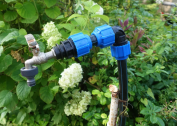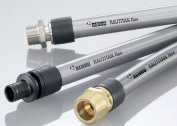The cast iron pipe has been widely used for many years in laying the sewer system. Over time, heavy metal began to be replaced by plastic products. Starting from the nineteenth century, cast-iron pipes were actively used in the process of constructing water supply systems in large cities. For example, in Peterhof, water is still supplied to the fountains precisely through a cast-iron water supply. And there is no need to change it in the near future.
Steel or cast iron
Long-term operation of the water supply system is not relevant in the city. The changing face of the city, in which something is constantly being demolished or rebuilt, requires a completely different approach to the implementation of the water supply of the urban infrastructure. The optimum service life of the water supply system is 40-50 years. Further operation is unprofitable, because the development of cities requires another more rational scheme of pipe layout.
Pig-iron lines began to give way to steel. The latter are cost-effective, the method of installation is much simpler. This applies to the technology of connecting elements of the water supply network to each other, where simple electric welding is used, and not chasing, which is used for sealing cast iron.
However, cast-iron pipes are present on the market, as there are still requirements for water supply networks, which only this material corresponds to.
State standard
GOST on cast-iron pipes for water supply was introduced during the Soviet Union in 1977. The standard was sometimes modified; the latest adjustments were made in 2011. The basis of the standard was the changes introduced in 1995, so the modern GOST has the number 9583-95.
Dimensional parameters
The length of the products is a fairly wide range, in which the minimum value is 2 m, the maximum is 10 m. At the same time, the length multiplicity is 1 m. Manufacturers also offer non-standard pipes, the length of which varies in the range of 2.5-10.5 m.
The diameter (passage) and wall thickness directly depend on each other. But in GOST it is indicated that cast iron pipes for water supply can be divided into three classes, which are based on the wall thickness: “LA”, “A” and “B”.
In the table of diameters, all ratios are well shown:
| Inner diameter mm | Wall thickness mm | ||
| LA | AND | B | |
| 65 | 6,7 | 7,4 | 8,0 |
| 80 | 7,2 | 7,9 | 8,6 |
| 100 | 7,5 | 8,3 | 9,0 |
| 125 | 7,9 | 8,7 | 9,5 |
| 150 | 8,3 | 9,2 | 10,0 |
| 200 | 9,2 | 10,1 | 11,0 |
| 250 | 10,0 | 11,0 | 12,0 |
| 300 | 10,8 | 11,9 | 13,0 |
| 350 | 11,7 | 12,8 | 14,0 |
| 400 | 12,5 | 13,8 | 15,0 |
| 500 | 14,2 | 15,6 | 17,0 |
| 600 | 15,8 | 17,4 | 19,0 |
| 700 | 17,5 | 19,3 | 21,0 |
| 800 | 19,2 | 21,1 | 23,0 |
| 900 | 20,6 | 22,3 | 25,0 |
| 1000 | 22,5 | 24,8 | 27,0 |
Depending on the indicated parameters, the weight of the tubular product changes. The minimum value is 11.3 kg of one linear meter, which corresponds to the class “LA” with a diameter of 65 mm and a wall thickness of 6.7 mm. The maximum value is 627 kg / lm, which corresponds to a class “B” pipe with a diameter of 1000 mm and a wall thickness of 27 mm.
Requirements
 The state standard specification clearly stipulates what requirements are imposed on the size of cast-iron pipes for water supply. They mainly relate to technological tolerances, i.e. deviations from nominal sizes:
The state standard specification clearly stipulates what requirements are imposed on the size of cast-iron pipes for water supply. They mainly relate to technological tolerances, i.e. deviations from nominal sizes:
- deviation of the length to a smaller or larger side - 20 mm;
- wall thickness - 0.5-1;
- outer diameter up to 300 mm - 4.5;
- above 300 mm - 5;
- inner diameter - 1-1.5.
The ovality of the pipe shape is not considered a marriage. The main thing is that the deviations do not exceed the guest standards. The weight of cast iron products should not exceed 5% of the norm.
In production, all batches of cast iron pipes undergo a mandatory pressure test. Testing is done with water, which is pumped under pressure into the test sample. Nominal pressure is determined by the class of products:
- pipes with a bore diameter of up to 300 mm are pressure tested: for the class “LA” - 25 kgf / cm², for “A” - 35, for “B” - 40;
- diameter from 300 to 600 mm: class "LA" - 20, "A" - 30, "B" - 35;
- more than 600 mm: "LA" - 20, "A" - 25, "B" - 30.
Typically, in a plumbing system, water moves at a pressure of 3-4 kgf / cm². So the test pressure is enough to talk about a large strength reserve.
Both ends of the pipe are cut perpendicular to the axis of the product. Deviations are allowed, but not more than 0.5 °. The transition plane from the bell to the pipe can be made in two versions: in the form of a slope or in the form of a ledge.
A standard requirement is to cover cast-iron pipes inside and outside with a protective coating that should not reduce the quality of the pumped water. In this case, the applied coating should not cause a decrease in the sealing of the joints. Manufacturers are ready to supply cast iron pipes without protective material, if such are the requirements of customers.
Rules and nuances of installation
 Cast iron water and sewer pipes are connected by a bell-shaped method. Products are made with two different ends. When connecting pipes, the small end is inserted into the large. But with such a connection, it is impossible to achieve maximum tightness of the dock. In addition, the water inside the water supply network moves under pressure.
Cast iron water and sewer pipes are connected by a bell-shaped method. Products are made with two different ends. When connecting pipes, the small end is inserted into the large. But with such a connection, it is impossible to achieve maximum tightness of the dock. In addition, the water inside the water supply network moves under pressure.
The main sealing method is chasing with a heel. This is an organic fiber treated with technical oil. The fibers are twisted and laid in the opening between the inner plane of the wall of the bell and the outer plane of the pipe. Then make a seal with the help of coinage, on which they beat with a hammer from above.
It is not enough to lay and tighten the heel. It is important to protect the oiled tourniquet from bacterial exposure, as well as from differences in humidity and mechanical stress. Therefore, the joint is additionally filled with various durable materials. Here are a few options:
- Cement brand M400. It is diluted with water in a ratio of 1: 9. The mixture fills the inner space of the socket and is choked until completely filled. After that, the junction for a day is closed with a wet rag.
- Expanding cement. It is diluted with water according to the recipe and poured into the joints. It is not necessary to mint material.
- A mixture of cement and asbestos in a ratio of 1: 2. The dry mixture is diluted with water and minted in the same way as in the first case.
- Molten sulfur and kaolin. The latter in the total volume is 10-15%. The mixture is a liquid substance, therefore it can only be used in vertically mounted risers.
- Lead. It is used in molten form.
- Lead in the form of a bar. It is laid on top of the heel and engraved so that it completely covers the entire plane.
Pipes can only be repaired if defects are minor. If large flaws, clamps made of steel or cast iron pipes are laid on top.
Cost of cast iron water pipes
The price of cast iron pipes for water supply depends on the diameter, wall thickness, the presence or absence of a protective coating. A few examples:
- ductile iron pipe with a diameter of 100 mm, coated with a protective varnish costs 6200 rubles .;
- 300 mm with a protective varnish - 20,000 rubles .;
- 1000 mm - 270,000 rubles.
Manufacturers offer cast iron pipes with a galvanized surface. They have improved performance, but the price is slightly higher.



